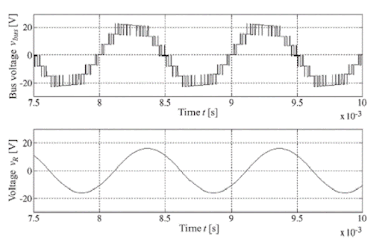ABSTRACT:
This
paper deals with the design and performance analysis of a three-phase single
stage solar photovoltaic integrated unified power quality conditioner
(PV-UPQC). The PV-UPQC consists of a shunt and series connected voltage compensators
connected back to back with common DC-link.The shunt compensator performs the
dual function of extracting power from PV array apart from compensating for
load current harmonics. An improved synchronous reference frame control based
on moving average filter is used for extraction of load active current
component for improved performance of the PVUPQC. The series compensator compensates
for the grid side power quality problems such as grid voltage sags/swells. The compensator
injects voltage in-phase/out of phase with point of common coupling (PCC)
voltage during sag and swell conditions respectively. The proposed system
combines both the benefits of clean energy generation along with improving
power quality. The steady state and dynamic performance of the system are evaluated
by simulating in Matlab-Simulink under a nonlinear load. The system performance
is then verified using a scaled down laboratory prototype under a number of
disturbances such as load unbalancing, PCC voltage sags/swells and irradiation variation.
KEYWORDS:
1. Power
Quality
2. Shunt
compensator
3. Series
compensator
4. UPQC
5. Solar
PV
6. MPPT
SOFTWARE: MATLAB/SIMULINK
CIRCUIT DIAGRAM:
Fig. 1. System Configuration PV-UPQC
Fig. 2. Performance of PV-UPQC under Voltage Sag and Swell Conditions
Fig. 3. Performance PV-UPQC during Load Unbalance Condition
Fig. 4. Performance PV-UPQC at Varying Irradiation Condition
Fig. 5. Load Current Harmonic Spectrum and THD
Fig. 6. Grid Current Harmonic Spectrum and THD
CONCLUSION:
REFERENCES:
[1]
B. Mountain and P. Szuster, “Solar, solar everywhere: Opportunities and challenges
for australia’s rooftop pv systems,” IEEE Power and Energy Magazine,
vol. 13, no. 4, pp. 53–60, July 2015.
[2]
A. R. Malekpour, A. Pahwa, A. Malekpour, and B. Natarajan, “Hierarchical architecture
for integration of rooftop pv in smart distribution systems,” IEEE
Transactions on Smart Grid, vol. PP, no. 99, pp. 1–1, 2017.
[3]
Y. Yang, P. Enjeti, F. Blaabjerg, and H. Wang, “Wide-scale adoption of
photovoltaic energy: Grid code modifications are explored in the distribution
grid,” IEEE Ind. Appl. Mag., vol. 21, no. 5, pp. 21–31, Sept 2015.
[4]
M. J. E. Alam, K. M. Muttaqi, and D. Sutanto, “An approach for online
assessment of rooftop solar pv impacts on low-voltage distribution networks,” IEEE
Transactions on Sustainable Energy, vol. 5, no. 2, pp. 663–672, April 2014.
[5]
J. Jayachandran and R. M. Sachithanandam, “Neural network-based control
algorithm for DSTATCOM under nonideal source voltage and varying load
conditions,” Canadian Journal of Electrical and Computer Engineering,
vol. 38, no. 4, pp. 307–317, Fall 2015.


































